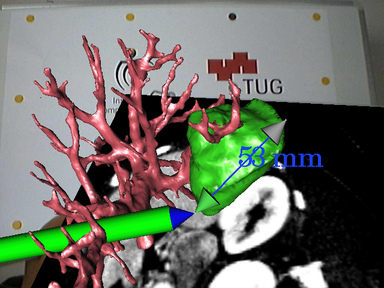Looking at how technology has developed and how augmented reality can be used in an interactive sense, I have looked at augmented reality in surgery.I found this column quite interesting and how this 3D space can be explored to help people.



Another application that Nintendo Wii has brought out is the Wii board. It fascinates me how a living space will slowly be turned into a full on gaming atmosphere where a user is not just sitting infront and interacting in a game but actually an actor in the game.
The one thing I hope that will occur is that photorealistic gaming – such as Crysis on the PC will eventually become interactive like the Wii. I would never go outside again!
So the Wii Board…
Access information on how the user is positioned and the direction of weight distributed by leaning one way or another – quite like a skater.
Wii Fit doesn't currently use the Wii Remote for gameplay, but imagine using a Wii Remote in your hand as a gun while leaning left and right on the Balance Board to take cover. Games could become a whole lot more immersive.
Comes with the Wii Fit collection include ski jumping. You crouch into a skiing position as the on-screen character shoots down a ramp, and spring up suddenly to leap from the ramp and then lean forward to get the biggest jump distance possible.
Another game has you leaning your torso left and right to make an on-screen footballer head back incoming balls. While another mini game gives you control of a tilting platform with rolling balls that you must guide into holes in the platform.
3D Monitors
This post will have a brief look at two 3D monitors from different manufacturers that will be on the market this year – and I am quite interested in! Really im thinking of the gaming benefits this will have but also for my line of work which is in 3D Visualisation it would again I’ll be pretty well off.
The first is a monitor designed By Zalman.
It uses polarisation rather than adding red and green, although special glasses are required. The vertical viewing range is a bare 12 degrees because of the nature of polarization. It blocks light so move too far off centre and things start to look strange. The horizontal viewing angle is a respectable 180 degrees so it's not all bad.

The second is by Sharp.
The technology is already used in Sharp's SH251iS mobile phone, on sale in 
Sharp demonstrated how the 3D monitor could be used to improve game play, by showing a demo of Quake where the terrain, monsters and other items appeared in three dimensions. The company also believes that its new system could have applications in sectors such as medical imaging and molecular modelling.
For this to work, the user has to be positioned directly in front of the monitor and at the correct distance away -- which appeared to be around 40 to 50cm.
"The 3D monitor should be launched commercially before the end of this year, priced at around 3,000 euros (around £2,000)," a Sharp spokesman said.
The prototype on display was a 15-inch flat screen. Sharp explained that the screen contained a 'parallax barrier TFT panel' that splits the light generated by the monitor such that alternate columns of pixels are seen by each eye, so that each sees a slightly different image.